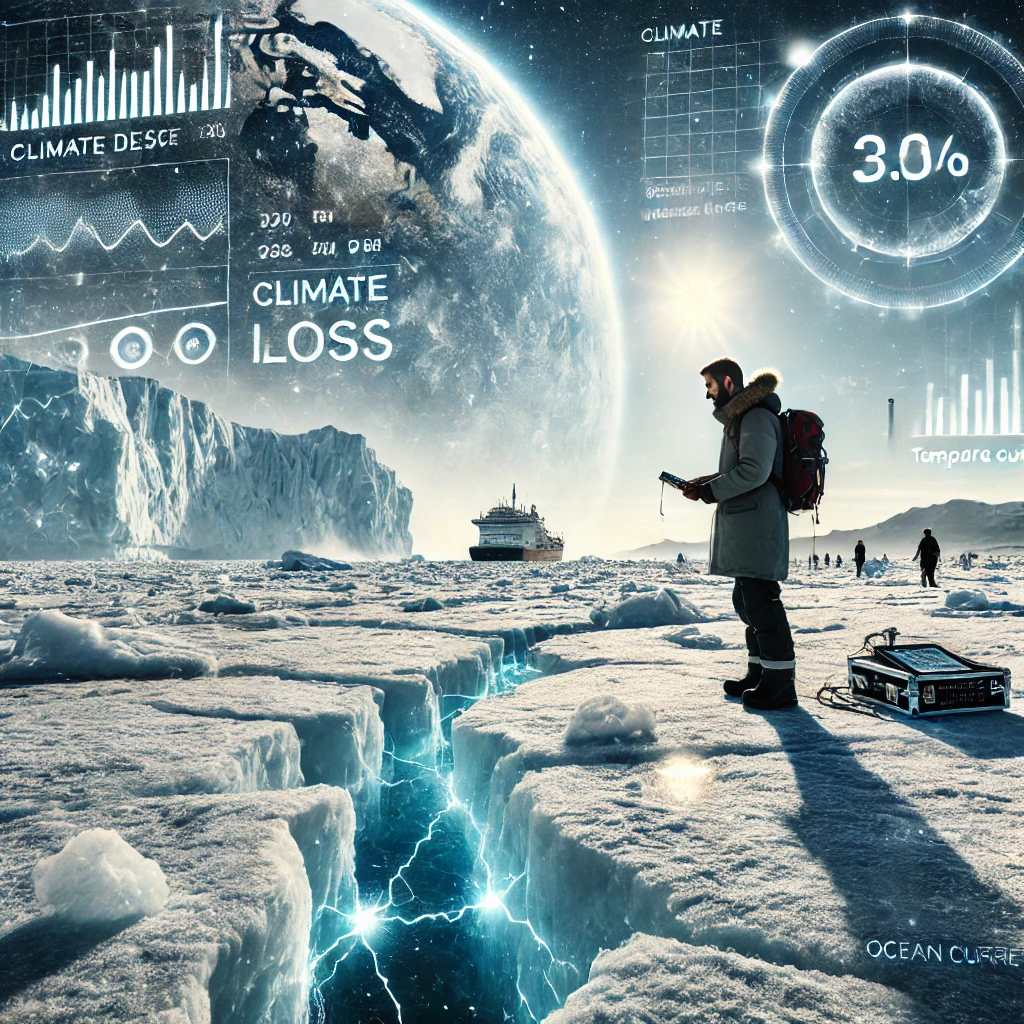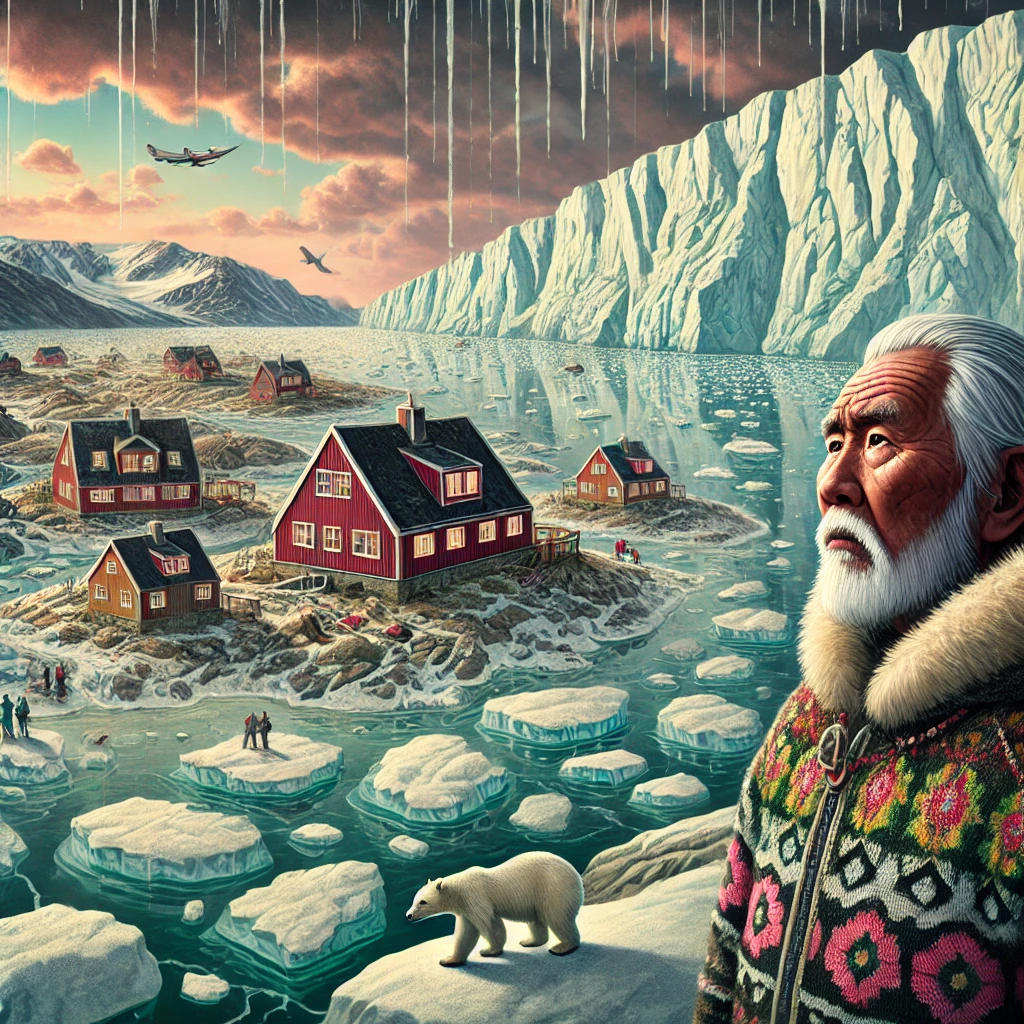Table of Contents
Introduction to Climate Change and Greenland
Climate change represents one of the most pressing challenges facing humanity today, manifesting through rising temperatures, shifting weather patterns, and increasing frequency of extreme weather events. Its effects ripple across the globe, influencing ecosystems, agriculture, and human populations alike. As greenhouse gas emissions continue to escalate, understanding these changes has become paramount for scientists and policymakers. Among the various locations impacted, Greenland has garnered attention as a crucial hub for climate research. Its vast ice sheets and unique geographic attributes present an unparalleled opportunity for scientists to observe and analyze climate processes in action.
Greenland is undergoing rapid changes, notably due to its Arctic location, where the effects of climate change are often amplified. The region’s ice sheets, which hold roughly 10 percent of the world’s fresh water, are melting at an alarming rate. This loss contributes significantly to global sea-level rise, making Greenland a natural laboratory for examining the consequences of climate change firsthand. The increased meltwater not only raises sea levels but also affects ocean circulation patterns, potentially leading to broader climate impacts worldwide.
The island’s diverse ecosystems, including tundra, glaciers, and marine environments, offer researchers a unique chance to study the interplay between climate change and biodiversity. Furthermore, Greenland’s geographical positioning allows for extensive seasonal variations in sunlight and temperatures, giving climatologists insight into how these factors influence climate dynamics. As the continent continues to change, it will present novel opportunities for understanding climate processes and their far-reaching effects globally. Greenland, therefore, stands as a vital field site for studying climate change and its implications for the planet.

The Greenland Ice Sheet and Its Importance
The Greenland Ice Sheet, covering approximately 1.7 million square kilometers, is the second-largest body of ice on the planet, surpassed only by Antarctica. This expansive ice sheet plays a crucial role in the Earth’s climate system, acting as a significant indicator of global climate change. Its size and structure, composed primarily of ancient, compacted snow, mean that it holds vast amounts of freshwater—about 2.85 million cubic kilometers in total. As temperatures rise due to climate change, the Greenland Ice Sheet has been experiencing accelerated melting, leading to alarming implications for global sea levels.
The melting of the Greenland Ice Sheet has direct consequences for coastal communities worldwide. The release of freshwater from the ice sheet contributes to rising sea levels, with estimates suggesting that it could account for up to one-third of the projected rise by 2100. As the ice sheet continues to lose mass, it alters ocean currents and atmospheric conditions, which can significantly affect weather patterns across the globe. This intertwining of local and global climate dynamics underscores the significance of this ice mass in climate research.
Impact of Melting Ice on Global Sea Levels
The melting ice in Greenland has emerged as a critical factor influencing global sea levels, with significant implications for coastal regions around the world. As the world experiences rising temperatures due to climate change, the ice sheets covering Greenland are undergoing accelerated melting. Research indicates that Greenland’s ice sheet contributes approximately 0.7 millimeters to global sea-level rise each year. However, projections suggest that this rate could increase dramatically in the coming decades if current warming trends continue.
The scientific community has developed various scenarios to illustrate how melting ice might affect sea levels. According to a recent report from the Intergovernmental Panel on Climate Change (IPCC), if global temperatures rise by 1.5 degrees Celsius, we could see an increase in sea levels ranging from approximately 0.3 to 0.6 meters by 2100. In more extreme scenarios, with a temperature rise of 2 degrees Celsius or higher, projections estimate that sea levels could rise by as much as 1.0 meters or more. Such significant changes in global sea levels pose dire threats to coastal communities, ecosystems, and infrastructure.

The implications of rising sea levels are particularly pressing for low-lying areas, where flooding, erosion, and habitat loss are already observed. For instance, many coastal cities, including Miami, New Orleans, and parts of Bangladesh, face increasing risks due to their proximity to the ocean. Understanding the dynamics of melting ice in Greenland is, therefore, essential for formulating effective climate adaptation strategies. Stakeholders must take into account not only the current state of melting ice but also the long-term projections concerning sea-level rise to help safeguard vulnerable communities and preserve ecosystems affected by climate change.
Unique Ecosystems and Biodiversity in Greenland
Greenland, the world’s largest island, is renowned not only for its vast ice sheets but also for its diverse ecosystems and unique biodiversity. The habitats range from the Arctic tundra to coastal wetlands, allowing various species to thrive in these harsh yet fascinating environments. Dominated by harsh climatic conditions, Greenland’s flora includes resilient plants such as mosses, lichens, and some flowering plants that have adapted to survive in extreme temperatures. Meanwhile, its fauna is equally unique, featuring iconic species such as polar bears, caribou, and various migratory birds that rely on these ecosystems for breeding and feeding.
As global temperatures continue to rise, Greenland’s ecosystems are becoming increasingly vulnerable to climate change. The melting of ice sheets not only affects the island’s landscape but also alters habitats, making it challenging for species adapted to Arctic conditions to survive. For instance, the polar bear’s hunting grounds are rapidly diminishing, impacting its ability to find food. As ice floes recede, seals, which are crucial prey for polar bears, are also experiencing changes in their breeding habitats, further threatening their populations.
The interconnectivity within ecosystems means that the loss of one species can have cascading effects on others. This reality underscores the urgent need for comprehensive climate research in Greenland. Studying the varying impacts on flora and fauna enables researchers to gather critical data, helping to predict future biodiversity losses. Such research efforts not only spotlight the immediate consequences of climate change on Greenland’s unique ecosystems but also emphasize the broader implications for global ecological health. Without understanding these changes, the appreciation and conservation of Greenland’s biodiversity remain at a significant risk, calling for immediate action within the realms of science and policy.
Collaborative Research Efforts in Greenland
Greenland has emerged as a pivotal location for international climate research, attracting scientists from various countries and institutions. This collaborative approach enables researchers to combine their expertise and resources, leading to a holistic understanding of the complex dynamics associated with climate change. The significance of Greenland in the context of global warming cannot be overstated; its vast ice sheets, glaciers, and permafrost serve as critical indicators of climate variation. Consequently, various research initiatives are underway that bring together scholars, climate specialists, and environmental scientists to share knowledge and data.
One prominent example of international collaboration is the Arctic Climate Change Research Program (ACRCP), which includes participants from countries such as Denmark, the United States, Canada, and Norway. Through this initiative, researchers focus on the effects of climate change on Greenland’s ice masses, which directly influence global sea levels. By pooling their findings, scientists enhance the interpretive framework for understanding how the Arctic’s rapidly changing landscape impacts worldwide environmental conditions.
In addition to ACRCP, scientists participate in programs like the Greenland Ice Sheet Monitoring Network (GrIS), aimed at continually assessing the state of the ice sheet through advanced satellite observations and ground-based measurements. This initiative exemplifies how shared technological capabilities and methodologies can yield valuable data to predict future climate scenarios. Furthermore, extensive collaboration with local communities provides culturally relevant context, ensuring that insights drawn from scientific investigations are reflective of both traditional knowledge and modern science.
The success of these multifaceted partnerships highlights the necessity of international cooperation in addressing climate challenges. As such, these efforts not only deepen our understanding of Greenland’s role in climate dynamics but also pave the way for innovative solutions that can mitigate the adverse effects of climate change globally.
Technological Innovations in Climate Research
Greenland has emerged as a significant focal point for climate research, owing in part to the advancements in technology that enhance the methods utilized in this endeavor. Satellite imagery serves as a cornerstone of contemporary climate research in the region, providing researchers with comprehensive views of large geographic areas. This method allows for the monitoring of glacial movements, ice sheet changes, and other key environmental indicators, facilitating a quicker understanding of the impacts of climate change.
In addition to satellite imagery, remote sensing technology has seen significant innovations that contribute to our understanding of Greenland’s nuanced climate dynamics. By employing a variety of sensors designed to detect different wavelengths of light, remote sensing enables scientists to gather critical data on temperature, moisture levels, and vegetation changes. These capabilities extend beyond surface observations, offering insights into subterranean ice dynamics that are essential for predicting future climate scenarios.
Ground-based monitoring techniques complement these remote technologies, allowing for localized data collection and verification. Research stations across Greenland employ state-of-the-art equipment such as weather stations, tide gauges, and ice-penetrating radar to capture precise data on atmospheric conditions and ice behavior. This dual approach—leveraging both satellite and ground-based tools—ensures that data collected is not only abundant but also of high quality.
The combination of these technological advancements has markedly improved data collection accuracy and analysis efficiency. Scientists can now share their findings in real-time, which is vital for global collaboration in climate research. This collaborative atmosphere fosters quick responses to environmental changes, ultimately aiding in effective policy-making and intervention strategies aimed at combating climate change. The ongoing investment in technological innovations continues to solidify Greenland’s reputation as a crucial site for advancing our understanding of climate dynamics.
Indigenous Knowledge and Climate Adaptation
The Indigenous peoples of Greenland possess a rich tapestry of knowledge rooted in centuries of lived experience and interaction with their environment. This traditional knowledge is becoming increasingly invaluable in the quest for climate adaptation. As scientists and researchers seek to understand the complex impacts of climate change on Greenland, the insights offered by Indigenous communities serve to complement and enhance scientific research.
Indigenous groups, such as the Kalaallit, have long recognized the subtle shifts in climate patterns, such as changes in animal migrations, shifting weather patterns, and alterations in ice cover. These observations are pivotal when it comes to climate adaptation strategies, as they provide a historical context that is often overlooked in mainstream scientific literature. For instance, the knowledge of how to navigate and manage the ecosystem sustainably can inform modern conservation efforts and resource management practices.
Moreover, Indigenous knowledge systems emphasize a holistic approach to understanding the environment, incorporating social, cultural, and spiritual dimensions. This perspective contrasts with many scientific methodologies that often isolate climate change phenomena for analysis. By fostering a reciprocal relationship where Indigenous knowledge and scientific research inform one another, a more comprehensive understanding of climate impacts emerges. This integration can lead to effective climate adaptation strategies tailored to local conditions and practices.

Engaging Indigenous peoples in the research process not only honors their heritage but also empowers these communities as active participants in climate discussions. Their lived experience offers practical wisdom that can guide adaptations to changing climatic conditions, ensuring that both traditional and scientific insights shape an adaptive response to the ongoing climate crisis. As such, the collaboration between Indigenous knowledge and scientific research in Greenland stands as a beacon of hope and a model for future climate resilience initiatives.
Future Prospects and Research Agenda
The future of climate research in Greenland is poised to play a pivotal role in understanding the implications of climate change on a global scale. As the Arctic region continues to experience warming at an alarming rate, questions surrounding ice melt, ecosystems, and carbon cycles remain crucial to address. Key scientific inquiries include examining the extent and rate at which Greenland’s ice sheet is shrinking, the resulting rise in sea levels, and the potential feedback mechanisms that may exacerbate global warming.
Further, the evolving weather patterns in Greenland invite a reevaluation of traditional models, prompting researchers to investigate how shifting climatic conditions impact local biodiversity. Understanding these interactions is essential, as they can influence not only Greenland’s environment but also that of surrounding areas. The urgency to build a comprehensive research agenda encompasses various interdisciplinary approaches, integrating glaciology, meteorology, and ecology to yield a holistic understanding of climate change dynamics.
In addition to physical observations, capturing socio-economic effects on the Greenlandic population offers a compelling angle for future studies. Indigenous communities, in particular, stand at the intersection of environmental changes and cultural resilience, making their input invaluable for holistic climate strategies. The incorporation of local knowledge and perspectives is necessary to enrich the climatological dialogue and ensure that research outcomes are applicable to those most affected by these changes.
Moreover, the necessity for international collaboration cannot be overstated, as climate change transcends borders. Collaborative efforts with global research initiatives can amplify the significance of work conducted in Greenland, addressing climate change on a more comprehensive scale. As the landscape of climate research continues to evolve, focusing efforts on Greenland will undoubtedly contribute to a deeper understanding of future climate scenarios and ultimately shape policy responses aimed at mitigating the impacts of climate change. The urgency for sustained exploration remains clear, highlighting the critical need for ongoing commitment to this vital area of research.
Conclusion: The Global Stakes of Greenland’s Climate Research
Greenland stands at the forefront of climate research due to its unique geographical and environmental characteristics. As the planet experiences unprecedented climate change, the ice sheets of Greenland serve as critical indicators of future global trends. The retreat and melting of these ice formations contribute significantly to rising sea levels, which poses a threat to coastal communities worldwide. This profound impact underscores the importance of sustained research efforts in this region.
Throughout the discussions highlighted in this blog post, we have explored how scientists utilize Greenland’s environment to better understand climate dynamics. The data derived from Greenland’s ice cores provides invaluable insights into historical climate patterns, enabling researchers to make more accurate predictions about future scenarios. Consequently, the ongoing study of these ice sheets is essential not just for local concerns but for global climate policy as well. The melting glaciers of Greenland represent a microcosm of the larger climate crises facing our planet, necessitating urgent action from researchers, policymakers, and society as a whole.
Support for climate research in Greenland must not wane, as the knowledge gained from ongoing studies is vital for developing effective climate adaptation and mitigation strategies. By strengthening international collaborations and funding for research initiatives in this region, we can enhance our understanding of climate change’s trajectory and its repercussions on global ecosystems. The stakes could not be higher; a failure to act could result not only in catastrophic environmental damage but also in significant socio-economic consequences across the globe.

In conclusion, it is imperative to recognize Greenland’s role as a global hotspot for climate research. Continuous investment and attention to this critical area will contribute to better-informed climate policies, ultimately fostering efforts to combat climate change effectively.





